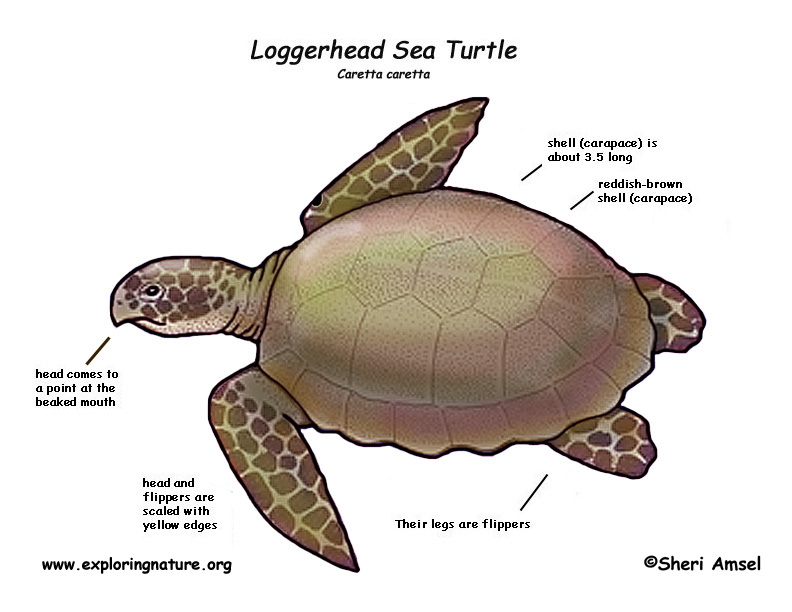

Loggerheads are found around the world in tropical to more seasonal (temperate) oceans. They are not found in cold waters.
They live and feed off the coasts in bays where rivers meet the ocean (estuaries) and in the shallow areas along coastlines (continental shelves).
They have a reddish-brown shell (carapace). Their head and flippers are scaled with yellow edges. Their shell (carapace) is about 3.5 feet long and they weigh about 250 pounds.
Babies hatch out at night to get to the ocean in the dark when predators can’t see them. They live for their first few years in floating mats of weeds (sargassum) on the ocean’s surface.
They eat squid (mollusks), crabs (crustaceans), fish, and other sea animals.
Man is the only real predator, though raccoon and other animals dig up and eat the eggs. They are also threatened by ocean pollution and their nesting sites being destroyed by human’s building on the beaches.
They nest in the summer along the southeastern U. S. coast, mostly in Florida. Females come out of the ocean onto the beaches at night to lay 100-125 eggs. One female may make 7 nests per season, one every 2 weeks. The eggs hatch in about 2 months.
Kingdom: Animalia
Phylum: Chordata
Subphylum: Vertebrata
Class: Reptilia
Order: Testudines
Family: Cheloniidae
Genus: Caretta
Species: C. caretta
When you research information you must cite the reference. Citing for websites is different from citing from books, magazines and periodicals. The style of citing shown here is from the MLA Style Citations (Modern Language Association).
When citing a WEBSITE the general format is as follows.
Author Last Name, First Name(s). "Title: Subtitle of Part of Web Page, if appropriate." Title: Subtitle: Section of Page if appropriate. Sponsoring/Publishing Agency, If Given. Additional significant descriptive information. Date of Electronic Publication or other Date, such as Last Updated. Day Month Year of access < URL >.
Amsel, Sheri. "Sea Turtle (Loggerhead)" Exploring Nature Educational Resource ©2005-2024. December 16, 2024
< http://www.exploringnature.org/db/view/Sea-Turtle-Loggerhead >

